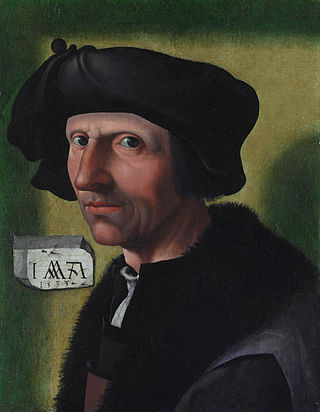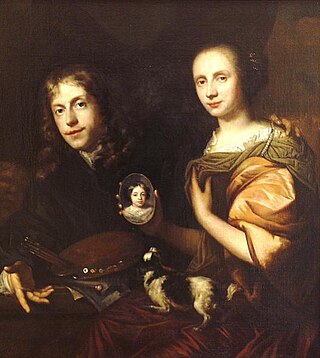
Jozef Israëls was a Dutch painter. He was a leading member of the group of landscape painters referred to as the Hague School and, during his lifetime, "the most respected Dutch artist of the second half of the nineteenth century."

The Hague School is a group of artists who lived and worked in The Hague between 1860 and 1890. Their work was heavily influenced by the realist painters of the French Barbizon school. The painters of the Hague school generally made use of relatively somber colors, which is why the Hague School is sometimes called the Gray School.

Cornelis de Bruijn or Cornelius de Bruyn, also formerly known in English by his French name Corneille Le Brun, was a Dutch artist and traveler. He made two large tours and published illustrated books with his observations of people, buildings, plants and animals.

Jacob Cornelisz van Oostsanen was a Northern Netherlandish designer of woodcuts and painter. He was one of the first important artists working in Amsterdam, at a time when it was a flourishing and beautiful provincial town.

Pieter Jacobsz Codde was a Dutch painter of genre works, guardroom scenes and portraits.

Adriaan van der Hoop was a Dutch banker and in the first half of the 19th century one of the richest men in the Netherlands. He also was an influential politician: a member of the city council, the States-Provincial in Haarlem and the Senate in The Hague. In his later years he became an important art and plant collector. On his death he left 250 paintings to the city of Amsterdam, who could barely pay the inheritance tax. In this way Van der Hoop contributed substantially to the collection of the Rijksmuseum.

Adriaen Hanneman was a Dutch Golden Age painter best known for his portraits of the exiled British royal court. His style was strongly influenced by his contemporary, Anthony van Dyck.

Cornelis Troost was an 18th-century actor and painter from Amsterdam.

Jan de Baen was a Dutch portrait painter who lived during the Dutch Golden Age. He was a pupil of the painter Jacob Adriaensz Backer in Amsterdam from 1645 to 1648. He worked for Charles II of England in his Dutch exile, and from 1660 until his death he lived and worked in The Hague. His portraits were popular in his day, and he painted the most distinguished people of his time.

Cornelis Kruseman was a Dutch painter, draughtsman, etcher, lithographer, silhouettist, paper-cut artist, and art collector. His works included portraits, biblical scenes, and depictions of Italian peasant life.

Paul Joseph Constantin Gabriël or Paul Gabriël was a painter, draftsman, watercolorist, and etcher who belonged to the Hague School.

Jan Weissenbruch was a 19th-century Dutch painter.

Cornelis Christiaan Dommersen (Dommershuijzen), was a Dutch painter and watercolourist. He signed his work as C.C. Dommershuizen, Chr. Dommelshuizen, Christian Dommelshuizen and C. Dommersen.

Pieter Cornelis Dommersen, born as Dommershuisen, was a Dutch painter and watercolourist active in England. He is also known as Pieter Cornelis Dommershuijzen and signed his work as P.C. Dommersen, P.C.Dommershuisen, or P.C. Dommershuizen.

Gerrit Braamcamp was a successful Roman Catholic distiller, timber merchant, and art collector from the Netherlands. One of the most important merchants in Amsterdam, he built a timber yard and shipyard at one end of Hoogte Kadijk, opposite the Dutch East India Company's own shipyard.

Matthijs Nicolaas Röling is a Dutch painter, active as graphic designer, wall painter, painter, draftsman, lithographer, pen artist, etcher, and academy lecturer. He is considered a kindred spirit of the 3rd generation of the Dutch Group of figurative abstraction. Röling is described as the "figurehead of contemporary figurative painting in the Netherlands."

Isabella Henriette van Eeghen, usually cited as I. H. van Eeghen, was a Dutch historian who worked for the Stadsarchief Amsterdam.

















